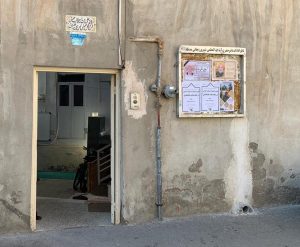Student Profile
Cameron Zargar
In the summers of 2017 and 2018, I conducted primary ethnographic interviews in Iran in order to better understand the dynamics of taqlīd, or, the attachment laypeople have to Twelver Shī‘ī jurists. I frequented mosques and shrines in Tehran, Qom, Mashhad, Mazandaran, and elsewhere thinking I would find interviewees who were loyal adherents to the opinions of the most prominent jurists, the marāji‘. Initially I only interviewed men, as I was restricted to the men’s sections of these sacred spaces. And the responses I received were generally in keeping with my expectations. Then, in July, 2017, I saw an opportunity to interview a woman. I was in the courtyard of the shrine of ‘Alī b. Mūsā al-Riḍā in Mashhad, where men and women were not separated. I approached a group of women, as I figured this would be less intimidating. A thirty-two-year-old reporter, “Sānāz,” agreed to be interviewed, and her words dramatically shifted my perspective.
Sānāz identified as a muqallid (one who nominally adheres to the opinions of a marja‘) but rejected legal opinions that she did not find reasonable. Furthermore, she stated that jurists were less objective than college professors and lacked awareness of society. This begs the question: why would she perform taqlīd at all? She stated, “The fact that I have a marja‘ is like a birth certificate, like saying I was born in Iran, something beyond my control. I thought it was something imposed upon me, that I had to choose one, because I heard that, I don’t know, I heard that one who does not perform taqlīd dies as an unbeliever…”
Immediately after my interview, I was whisked away to the police station of the shrine. After about an hour of silence, the police explained to me that only official media is allowed to conduct interviews in the shrine. However, the underlying issue was apparently that one could not simply approach women in religious settings. I was let go when they could not think of an official charge, but I became resigned to the fact that my interviewees would all have to be male.
In May, 2018, thanks to the Lenart Graduate Travel Fellowship, I returned to Iran to continue my work. When visiting the mosque of Jamāl Ābād in Tehran, I found the courage to ask a female custodian if she could help arrange interviews with women. She was more than happy to help. It was the month of Ramadan at the time, and most of these women spent hours in the mosque every day attending classes on Islamic legal rulings and the Qur’an and then staying for congregational prayer. All of them wore some form of the traditional chādur (long black cloak that covers the entire body) and professed that they perform taqlīd. It is for these reasons that I found their responses rather surprising.
The women at the Jamāl Ābād mosque mentioned standards for fatwas that were not to be found in legal works. For instance, fatwas must be “up to date,” consider the demands of society and women’s rights, and appeal to one’s own reasoning. A number of my interviewees indicated that they would ignore fatwas that did not fulfill all of these conditions. And yet, they remained muqallids, even though the vast majority of them did not actually refer to the legal opinions of their particular marāji‘. Furthermore, many of these individuals considered those who do not perform taqlīd to be jeopardizing their status in the Afterlife. This brings me back to the words of Sānāz and the idea of taqlīd as identity or a marker of faith.
My fieldwork reveals that the primary function of taqlīd is that it provides people with coherent identities. While in theory taqlīd means a strict adherence to the fatwas of a particular jurist, most of my interviewees do not read fatwa collections or even refer to the official offices of their marāji‘. Rather, they expressed that the opinions of the marāji‘ are all essentially the same, which means that they can simply find a legal opinion that is widely accepted in their society. Thus they learn their Islamic laws from family members, in school, or from local scholars. However, they still see taqlīd to a particular marja‘ as a necessity, almost like an article of faith. This reveals something about how deeply entrenched the meso-level public culture of taqlīd is in Iranian society. But it can also tell us something about the reality of traditional legal authority in the contemporary world. This is what I am exploring in my dissertation at UCLA, and I look forward to sharing my findings.


